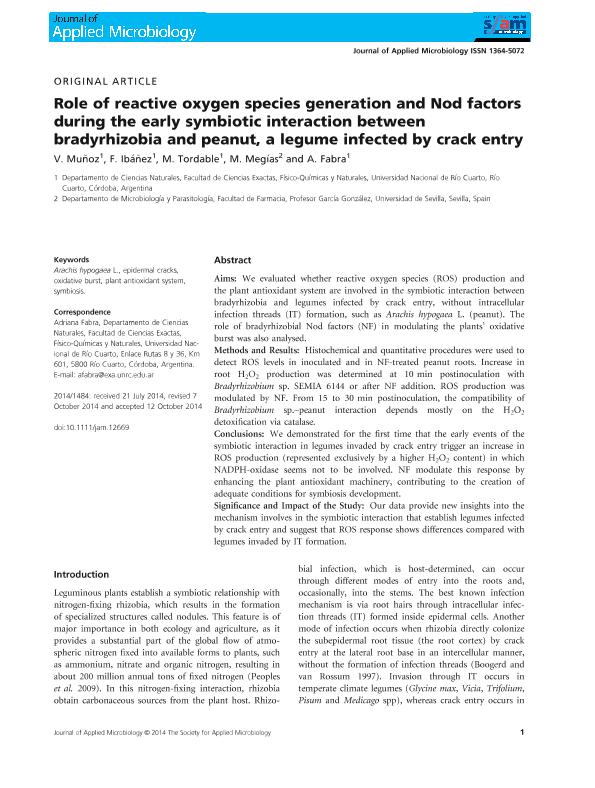Artículo
Role of reactive oxygen species generation and Nod factors during the early symbiotic interaction between bradyrhizobia and peanut, a legume infected by crack entry
Muñoz, Vanina Laura ; Ibañez, Fernando Julio
; Ibañez, Fernando Julio ; Tordable, Maria del Carmen; Megías, M.; Fabra, Adriana Isidora
; Tordable, Maria del Carmen; Megías, M.; Fabra, Adriana Isidora
 ; Ibañez, Fernando Julio
; Ibañez, Fernando Julio ; Tordable, Maria del Carmen; Megías, M.; Fabra, Adriana Isidora
; Tordable, Maria del Carmen; Megías, M.; Fabra, Adriana Isidora
Fecha de publicación:
11/2014
Editorial:
Wiley
Revista:
Journal of Applied Microbiology
ISSN:
1364-5072
Idioma:
Inglés
Tipo de recurso:
Artículo publicado
Clasificación temática:
Resumen
Aims: We evaluated whether reactive oxygen species (ROS) production and the plant antioxidant system are involved in the symbiotic interaction between bradyrhizobia and legumes infected by crack entry, without intracellular infection threads (IT) formation, such as Arachis hypogaea L. (peanut). The role of bradyrhizobial Nod factors (NF) in modulating the plants’ oxidative burst was also analysed. Methods and Results: Histochemical and quantitative procedures were used to detect ROS levels in inoculated and in NF-treated peanut roots. Increase in root H2O2 production was determined at 10 min postinoculation with Bradyrhizobium sp. SEMIA 6144 or after NF addition. ROS production was modulated by NF. From 15 to 30 min postinoculation, the compatibility of Bradyrhizobium sp.–peanut interaction depends mostly on the H2O2 detoxification via catalase. Conclusions: We demonstrated for the first time that the early events of the symbiotic interaction in legumes invaded by crack entry trigger an increase in ROS production (represented exclusively by a higher H2O2 content) in which NADPH-oxidase seems not to be involved. NF modulate this response by enhancing the plant antioxidant machinery, contributing to the creation of adequate conditions for symbiosis development. Significance and Impact of the Study: Our data provide new insights into the mechanism involves in the symbiotic interaction that establish legumes infected by crack entry and suggest that ROS response shows differences compared with legumes invaded by IT formation.
Archivos asociados
Licencia
Identificadores
Colecciones
Articulos(CCT - CORDOBA)
Articulos de CTRO.CIENTIFICO TECNOL.CONICET - CORDOBA
Articulos de CTRO.CIENTIFICO TECNOL.CONICET - CORDOBA
Citación
Muñoz, Vanina Laura; Ibañez, Fernando Julio; Tordable, Maria del Carmen; Megías, M.; Fabra, Adriana Isidora; Role of reactive oxygen species generation and Nod factors during the early symbiotic interaction between bradyrhizobia and peanut, a legume infected by crack entry; Wiley; Journal of Applied Microbiology; 118; 1; 11-2014; 182-192
Compartir
Altmétricas



